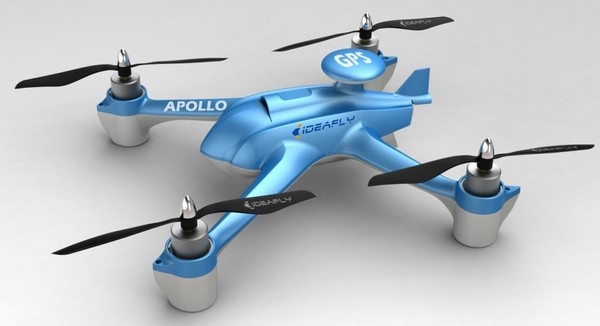- Quadrocopters
- Blog
- 3D Robotics (3DR)
- Aerix
- Aeryon
- Air Fun
- AirDog
- Airselfie
- Align
- Aosenma
- Atlas Dynamics
- Autel Robotics
- Blade
- Blue Robotics
- Cheerson
- Chitwan
- DJI
- How to fly a dji drone?
- DJI Spark review
- Review of DJI Inspire 1 - quadrocopter with 4K camera
- Review of quadrocopters DJI Phantom 4: Step into the Future
- DJI Phantom 3 review: improved Phantom 2 with the camera 4K
- The DJI Phantom 2 Vision Plus review - Phantom Series crown
- DJI Phantom 2 Vision review - the most famous quadrocopter
- DJI Phantom 2 review: spirit flight
- DJI Phantom FC40: quadrocopter Phantom 1 with the camera
- DJI Phantom 1 Review: the founder of the popular series quadrocopters
- Draganfly
- Dromida
- Eachine
- Estes
- GDU
- GoPro
- Helimax
- Hover Camera
- Hubsan
- Idea-Fly
- JJRC
- Insurance of drones
- JJRC JJPRO X2: the first racing drone is cheaper than 90 dollars
- JJRC H37 Elfie: a cheap folding selfie drone
- JJRC V686 review: the most technologically quadrocopter from JJRC
- JJRC H12C review: quadrocopter with a 5-megapixel camera for $ 70
- JJRC H8C: the main competitor to quadrocopter Syma X5C?
- JJRC H6C: mini quadrocopter with the camera for $ 40
- JJRC H5C: a clone of quadrocopter Syma X5C
- JJRC H9D: quadrocopter with FPV-camera for $ 100
- JJRC H3: quadrocopter with wheels
- JJRC JJ-600 "low-speed" quadrocopter with a VGA-camera
- JJRC F182: fast quadrocopter for beginners
- JJRC JJ-1000: light and smart mini quadrocopter for beginners
- JJRC JJ-810: a copy of quadrocopter Cheerson CX-10
- JJRC JJ-800 review: conventional radio-controlled mini-quadrocopter
- JXD
- Lily
- Mikrokopter
- MJX
- Nine Eagles
- Parrot
- PowerVision
- Sbego
- Selfly Camera
- Sky Hero
- Sky Viper
- SmartDrone
- SpeedWolf
- Swellpro
- Syma Toys
- Team BlackSheep (TBS)
- TRAXXAS
- Turbo Ace
- UDIR/C
- UVify
- Walkera
- Wingsland
- WLtoys
- Xaircraft
- Xdynamics
- Xiaomi
- Xiro
- Youbi
- Yuneec
- Zerotech
IdeaFly Apollo: analogue - Blade 350 QX and DJI Phantom 1
Quadcopter IdeaFly Apollo from the Chinese company Idea-Fly can be considered an analogue of the Blade 350 QX and DJI Phantom 1. It costs about the same, but what about its capabilities and characteristics? Let's take a look!

Overview
Idea-Fly Apollo comes with 'Ready-to Fly'. This means that by giving 5-6 hundred dollars you get a fully operational quadrocopter, which you do not need to collect and that you do not need anything else to run. If you want to receive video from the camera in real time, then see that the bundled Wi-Fi transmitter and receiver (Wireless Video Transmitter / Receiver).
As you probably already guessed, Apollo is equipped with a GPS module that is capable of working with 6 satellites. This means that, in order to improve the safety of the quadrocopter, it is equipped with a home return and autopilot function, and in order to improve stability there is a special flight mode when the copter moves more smoothly in the air, allowing better images and more stable video output.

The motors of the Apollo are brushless, equipped with electronic speed controllers to improve the flight characteristics. The propellers are made of carbon fiber, which makes them light and strong at the same time. It is also possible to install protective covers, although in open spaces they are useless and only increase the weight of the copter, reducing the time of its flight.

As for the battery, it has a capacity of 2200mAh. Its volume is enough for 10-15 minutes of flight, depending on the congestion of the quadrocopter. The battery is charged for one hour.
The control panel operates at the usual 2.4Ghz frequency, the video is transmitted at a frequency of 5.8Ghz.
Like the Blade 350 QX, the Idea-Fly Apollo is equipped with a 2-axle cardan suspension, which is officially compatible with GoPro cameras, but in fact with its multiple Chinese clones and analogs.

A significant disadvantage of the quadrocopter can be called a short range of control - only 300 meters in open spaces.
Specifications
Quadcopter
Dimensions: 280 x 310 mm
Diagonal size: 350 mm
Operates at a temperature of -10 ° C ~ 50 ° C
Power Consumption: 3.12W
Maximum weight at which to take off: <1200 grams
Flight accuracy (GPS mode): Vertical: 0.8 m; Horizontal: 2.5 m
Maximum angular yaw rate: 300 ° / sec
Maximum angle of inclination: 45 °
Maximum take-off / landing speed: 4 m / s
Maximum flight speed: 5 m / s
Flight time: 10-15 minutes
The charger and battery
AC Input Voltage: 100-240V
Charging current: 1A / 2A
Current consumption for compensation: 200mA
Power consumption: 20W
Battery type: lithium polymer
Capacity: 2200mAh
Remote control
Operating frequency: 2.4GHz ISM
Control Channels: 6
Radius: 300 yd range
Receiver sensitivity (1% PER):> -93dBm
Power consumption: <20dBm
Operating voltage: 80 mA @ 6V
Batteries AA: 8 pieces
Video
conclusions
IdeaFly Apollo is a worthy analogue of the American Blade 350 QX and Chinese DJI Phantom 1. True, it is more expensive than the first, but it has a longer range of controlled flight, yielding at the same time to the first Phantom (the one has a flight range of 1 km). But he can lift a little more weight than Phantom 1.
If to generalize, then Apollo is something worse, but something better than analogues at the same price. It can not be said that he is better on his head, but he is definitely not worse. Should I take the Idea-Fly Apollo? Yes, if you need a quadrocopter with a camera on the radio, capable of shooting a good video from the air.
